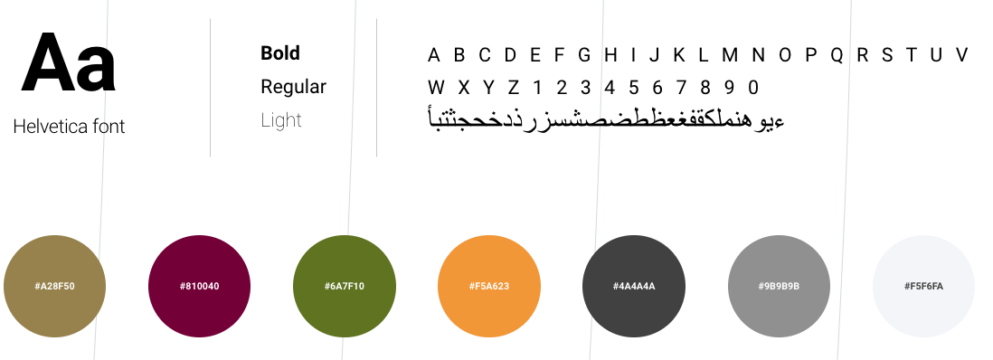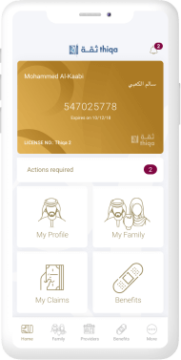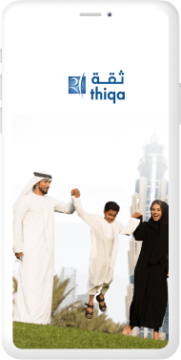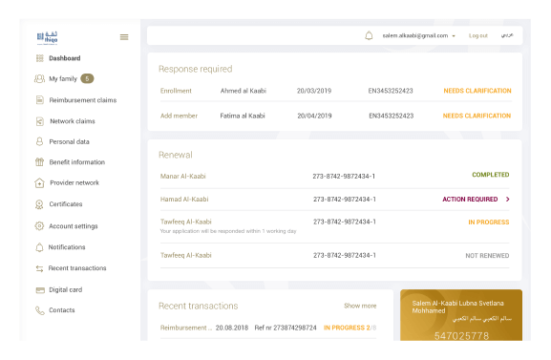
Case study
Service design for the UAE national health insurance company
Daman is a National Health Insurance Company in the United Arab Emirates (UAE), offering national health insurance and several other health insurance services.
The principal goal Daman wished to achieve was to reduce paperwork and workload arising from processing insurance claims and insurance certificates manually. For example, every customer had to submit 20-25 pages of printouts, which had to be scanned, copied, archived and for the most part also entered manually into the Daman systems. This took a lot of time and often led to human error due to manual data entry.
The goal of the project was to develop a platform of e-services, that would allow digitalization of the whole insurance program and to transfer all customers to the web or the mobile app (both iOS and Android).
Challenge
The different business processes and additional insurance products of the seven emirates added an extra layer of complexity. These differences meant that the system had to meet rigorous conditions. At the same time the final product had to offer a seamless user experience to the customer without the complexities showing. The same expectations applied to the user journey of the employees who required access to more functions.
The final goal of the project was to make the background processes as automatic as possible so as to reduce the manpower needs at the front end. To achieve this, the project was broken down into several parallel workflows (incl. transformation of the process, service design, integrations and data collection, implementation of the system, change management). Service design played a focal role in the project, changing the way the Daman staff worked and raising the customer UX to a completely new level.
Design process
We launched the project by first mapping the AS-IS processes for both the employees and customers in order to have a clear overview of the business and the details related to the service. In addition, we conducted observational studies in the customer offices in order to map the workflows of both the front and back office staff. We also interviewed the employees and customers to pinpoint any details in their user journey that we may have initially missed.
Based on the results, we defined the personas and use cases of the users and mapped their user journeys, emphasizing the pain points and opportunities of the AS-IS situation. As the next step, we created the TO-BE service design map.
At the same time, we started developing the visuals for the new e-services and intracompany applications. As we were working out the design principles, we held design workshops with the customer and conducted user tests with the end users to validate the design.
Typography and colors

Based on the input gathered, we created a Click Dummy test and conducted a user survey. The survey was carried out both in English and Arabic.
The results of the user survey allowed us to test the hypotheses about user experience and also alleviate the concerns of stakeholders who were worried about the new solution being too difficult for the end users.
In the course of the work, it became clear that UAE locals are used to a customer-centric approach. They like to be appreciated and taken care of. So, we also redesigned their insurance card to give them that feeling.
Results
18
The project took around 18 months. Work started in July 2018 and was completed by March 2020.
2
The solution enabled users to access e-services simultaneously on 2 different platforms
– the web and the mobile app.
300,000
The solution has around 300,000 users who can now use their smart devices to digitally order and process insurance services.
A closer look at the solution





Transform your business and services
We help you create business models, products, and services that fill unmet consumer needs and wants. Product innovation, digital-first design, emerging technologies, and customer insights support innovation and give you a competitive advantage.
Find out moreGet in touch
Let us offer you a new perspective.


